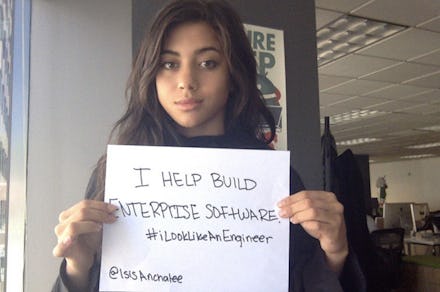Female Engineers Are Tearing Down Sexist Stereotypes With #iLookLikeAnEngineer

Fourteen percent.
That's roughly the percentage of female engineers working in the United States in 2012. The figure reflects the realities of both the industry and larger STEM fields where women are chronically underrepresented, despite being overrepresented in the university population in the United States.
Isis Anchalee is part of that minority. In an essay posted to Medium, Anchalee opened up about some of the struggles she faced as a woman in the field.
"I've had men throw dollar bills at me in a professional office (by an employee who works at that company, during work hours)." she wrote. "I've had an engineer on salary at a bootcamp message me to explicitly 'be friends with benefits' while I was in the interview process at the school he worked for."
Anchalee first drew attention after she was part of an ad campaign by her company OneLogin that appeared on the San Francisco Bay Area Rapid Transit. She was prompted to write her essay after receiving a torrent of negative and sexist feedback.
"We have a deep lack of public female role models if my smiling face with unbrushed hair on a white wall generated so much controversy," she told Mic. "This is a very multifaceted and complex issue. It starts as early as planting the right seeds during childhood development. Historically girls have been encouraged to partake in more socially engaging games while boys got to build things with Legos."
At the end of her essay for Medium she included a challenge to her readers:
"Do you feel passionately about helping spread awareness about tech gender diversity? Do you not fit the 'cookie-cutter mold' of what people believe engineers 'should look like?' If you answered yes to any of these questions I invite you to help spread the word and help us redefine "what an engineer should look like." #iLookLikeAnEngineer.
The response was overwhelming as women across the Internet posed for their own #ILookLikeAnEngineer photos. "I'm overwhelmed by both joy and gratitude for how well my message is being received," said Anchalee.
The difficulty women face in engineering is part of a larger problem the gender has had integrating within all STEM branches. Divya Nag, a millennial medical entrepreneur, often faced scorn and derision when she would participate in the two companies she helped found. "I had to bring, like, male co-founders into [investor] meetings," she told Mic. "People didn't take me very seriously."
That misogyny was encapsulated by Nobel Prize winner Tim Hunt, who told a conference in South Korea he didn't like working with women because "Three things happen when they are in the lab... You fall in love with them, they fall in love with you and when you criticize them, they cry."
The situation is even bleaker for black women. Between 1973 and 2012, 22,172 white men received physics doctorates while only 66 black women could claim the same. Between 2002 and 2012 similarly bleak numbers plagued mathematics and statistics and computer science as well.
"Increasing awareness and encouraging these types of conversations is one powerful step," said Anchalee when asked for ways address the imbalance. "Increasing the number of diverse role-models and mentors will ultimately help expand the diversity of the pipeline."
Anchalee said she and a few others were working on a "location-based storytelling app" called ilooklikeanengineer.com to help continue to move the conversation forward and "allow people to share their own personal stories about diversity issues in tech."